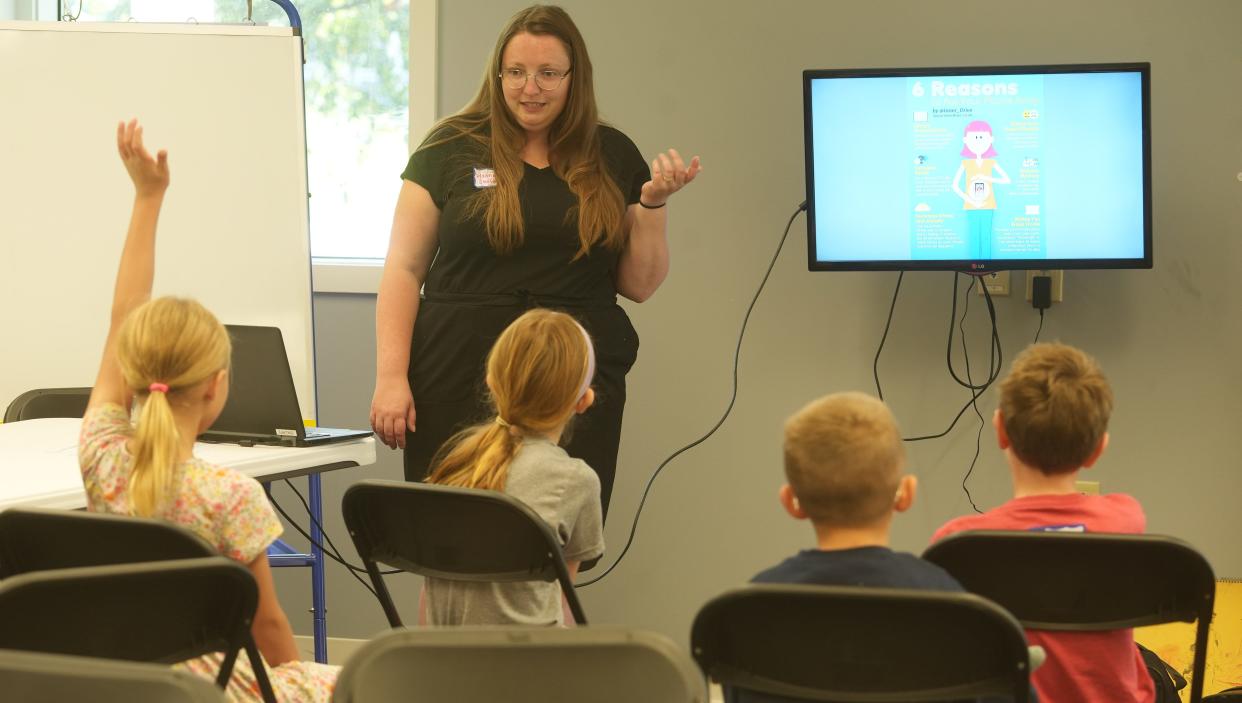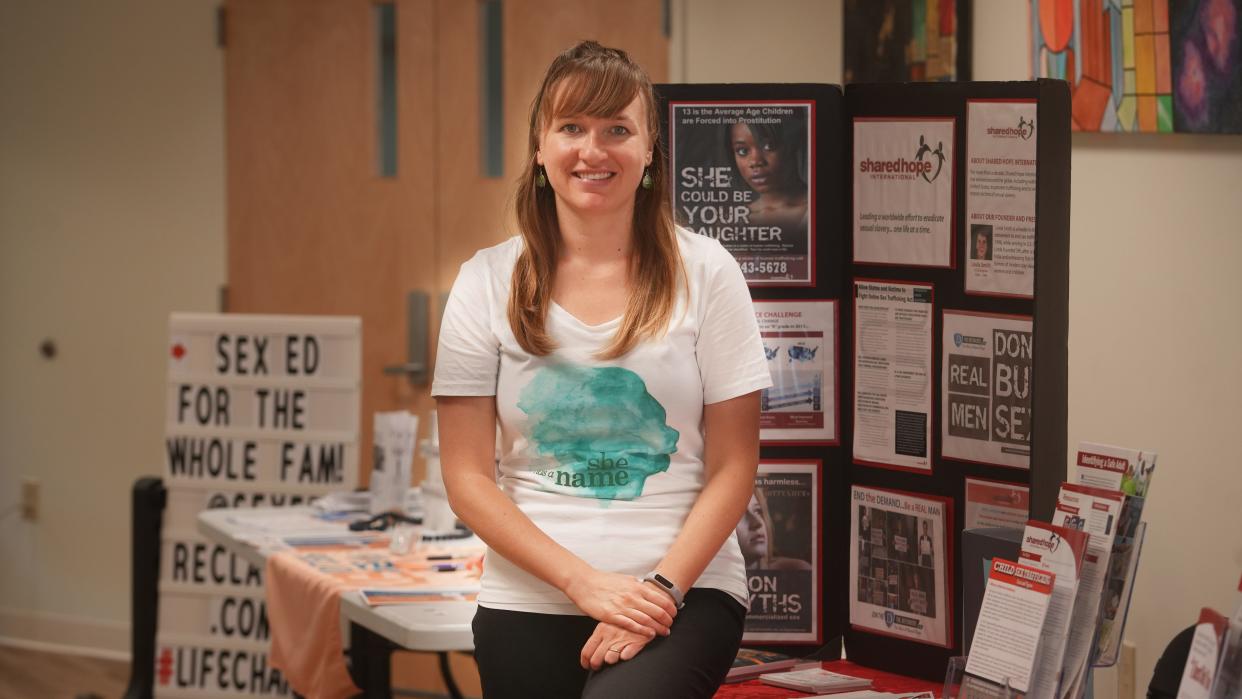Ohio often prosecutes child sex trafficking victims for crimes they were forced to commit

In Ohio, the nightmare of children who are forced into sex slavery doesn't always end when they escape the criminals trafficking them, advocates say.
Instead, state laws have the potential to retraumatize child survivors by allowing them to be prosecuted for crimes they were forced to commit against their will by sex traffickers, several advocates told The Dispatch.
Statewide, child victims are treated like witting prostitutes and often prosecuted for solicitation, drug trafficking and money laundering, say advocates such as Micayla Wilson of Gracehaven, a faith-based nonprofit group headquartered in Columbus that offers care and housing to trafficked youth.
"This system doesn't make sense," said Wilson, who works with trafficked youth across the state and at Gracehaven's residential home in central Ohio. "We're spending all this time punishing the wrong person."
Changing Ohio's practices has been challenging, she said because the state's home rule power allows for self-governance of these kinds of issues in all 88 counties, she said.
So far, only a handful of the state's counties, including Franklin and Delaware, have introduced programs to prevent the prosecution of child trafficking victims, said Maria Busch, state anti-trafficking coordinator for the Governor's Human Trafficking Taskforce.
Meanwhile, sex trafficking has become the second fastest-growing criminal industry in the United States, with an estimated 1,000 victims of all ages annually in Ohio, according to Gracehaven. As of June 2022, Ohio ranks fifth in the nation for total trafficking cases, according to the National Human Trafficking Hotline with Columbus ranked ninth, as one of the worst cities in the nation.
There were more than 17,200 reports of child sex trafficking nationwide in 2021, according to the National Center for Missing and Exploited Chidden. Local figures for child victims weren't readily available.
"Oftentimes they're being trafficked by people that they love," said Wilson, who gets 20 referrals a week for girls who she said need safe housing and services such as those offered at Gracehaven to heal. "It starts out as 'love.'"
Ohio's human trafficking laws
That's not to say that there are no protections for human trafficking victims in Ohio, advocates concede.
The state has made strides to crack down on human trafficking in recent years by increasing punishment for perpetrators, creating diversion programs for minors as alternatives to detention, and enhancing screening to identify child victims by hiring an employee to screen every youth who goes through the state's Department of Youth Services, Busch said.
If children are identified as having been trafficked, there are efforts to get them into a diversion program — which, if completed, can mean their charges are dismissed — instead of sending them to detention, she said.
But advocates say Ohio's law doesn't go far enough when it comes to helping survivors avoid the criminal justice system altogether. Twenty-nine states and Washington, D.C. have laws that keep trafficked children from having to go through the court system at all, even for diversion programs, McCoy said.
Part of the problem is Ohio doesn't screen children early enough to prevent them from being arrested in the first place, Wilson said. When child trafficking victims are arrested, they're sent to court, not to programs like Gracehaven, which has the only therapeutic group home for survivors in the state, she added.
"It's really easy to look at a kid and be like that's just their behavior, that's just what they're like, that's just who they are and not seeing what's happening underneath of that behavior," Wilson said.
Currently, minors who are identified as having been trafficked in Ohio are connected to community-based programs, but they still have to go through the justice system to get to those programs that offer counseling and other services.
"Not only has this proven unsuccessful, but it conflicts with the basic premise of safe harbor, which is that minors should not be held liable for conduct that reflects their victimization, including engagement in commercial sex," said Sidney McCoy, director of Shared Hope International, a Washington-based nonprofit Christian organization that works to prevent sex trafficking and help survivors.
Survivors may also end up going back to their trafficker, Wilson said, if they feel they have no other choice because of a criminal record which may make it harder for them to get employment and safe housing. That's where case management services can also come in to help them get access to clothes, food and other resources.
“As soon as they touch the juvenile justice system, kids are more at risk for being exploited, more at risk for learning things we don’t want them to learn," Wilson said.
Identifying survivors
Gracehaven and the governor’s task force are working now to help a few county court systems get the know-how to screen children before they're ever arrested for a crime.
The hope is that the local screening process can be replicated across the state, Busch said.
Local screening by the select counties has found more victims than you would expect based on the state screening numbers, indicating that the problem is probably far worse than anticipated, she said. That's because the screening — which includes looking for risk factors such as truancy, getting into trouble frequently, and their parents not knowing where they are — takes place in a child's home county before they enter the state juvenile justice system.
From 2021 to 2022, there were 902 Ohio children screened and 19 potential trafficking victims identified by the Ohio Department of Youth Services, Busch said. In Hamilton and Delaware counties, where the task force is funding the development of screening processes, 69 and 24 minors, respectively, were found to be experiencing or at high risk of being trafficked in 2022. That's more than was identified for the entire state in just two counties.
If kids are screened earlier, the hope is that they won't be punished for crimes they committed while they were being trafficked but instead will get the treatment they need to heal from the trauma they experienced, advocates say.
Children who are being trafficked may be acting out, missing school, and getting in trouble with the law, among other troubling behavior, Wilson said.
"Oftentimes, these are ways that kids are communicating their needs, and we're missing it because it doesn't fit into the norms, or it's disruptive, or it's uncomfortable," she said.
Wilson added that the youths at their group home are "the kids who have fallen through every single crack."

Healing and help
Child trafficking survivors are often sent to juvenile detention because officials say there is nowhere else for them to go. One argument often used by law enforcement, McCoy said, is that if police don't arrest girls being trafficked, they'll just go back on the streets.
"Housing and safe housing is probably the No. 1 gap that is missing nationwide to address human trafficking," McCoy said. "Giving these victims a place to stay is kind of an answer to that, so we don't have to rely on the juvenile justice system (or the foster care system) to be safe housing."
The Gracehaven group home for girls ages 11 to 18 is an anomaly in Ohio. Situated on five acres in a central Ohio location that isn't shared to protect survivor's safety, it can only host eight girls at a time due to a lack of space and funding. The nonprofit is funded by state and federal grants, Medicaid and private donations.
On campus, kids get mental health counseling, case management services and more specialized care during their stay, which for most individuals ranges from six to eight months.
Survivors are referred there from county children services agencies and Ohio RISE, a specialized Medicaid plan for youth with complex needs, and receive their guardian's consent to stay at Gracehaven.
In 2022, Gracehaven — which is affiliated with Central Ohio Youth for Christ — served 132 teenagers through its statewide case management services and 13 who were in residential care. The campus has the capacity to house 24 girls in residential treatment but is only licensed for 12 and currently has four staying there. There isn't enough multipurpose or classroom space for more than eight girls to live there, Wilson said.
It has been trying to expand its campus and capacity for years, said Vicky Thompson, director of development for Central Ohio Youth for Christ. Despite a $2.5 million grant from the state that Gracehaven received before the pandemic, the organization still doesn't have enough money to fund the expansion it needs, she said.
"There's a special kind of healing process that has to happen with children," Thompson said. "In six or eight months, we don't reverse all the trauma that's happened to them. ... The goal is to help them feel safe, help them become advocates for themselves and to help them thrive in their next (home)."
dking@dispatch.com
@DanaeKing
This article originally appeared on The Columbus Dispatch: Should children be charged for coerced sex acts? In Ohio, they are
